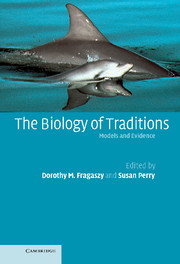Book contents
- Frontmatter
- Contents
- List of contributors
- Preface
- Acknowledgements
- 1 Towards a biology of traditions
- 2 What the models say about social learning
- 3 Relative brain size and the distribution of innovation and social learning across the nonhuman primates
- 4 Social learning about food in birds
- 5 The cue reliability approach to social transmission: designing tests for adaptive traditions
- 6 “Traditional” foraging behaviors of brown and black rats (Rattus norvegicus and Rattus rattus)
- 7 Food for thought: social learning about food in feeding capuchin monkeys
- 8 Traditions in mammalian and avian vocal communication
- 9 Like mother, like calf: the ontogeny of foraging traditions in wild Indian Ocean bottlenose dolphins (Tursiops sp.)
- 10 Biological and ecological foundations of primate behavioral tradition
- 11 Local traditions in orangutans and chimpanzees: social learning and social tolerance
- 12 Developmental perspectives on great ape traditions
- 13 Do brown capuchins socially learn foraging skills?
- 14 Traditions in wild white-faced capuchin monkeys
- 15 Conclusions and research agendas
- Further reading
- Index
- References
7 - Food for thought: social learning about food in feeding capuchin monkeys
Published online by Cambridge University Press: 27 October 2009
- Frontmatter
- Contents
- List of contributors
- Preface
- Acknowledgements
- 1 Towards a biology of traditions
- 2 What the models say about social learning
- 3 Relative brain size and the distribution of innovation and social learning across the nonhuman primates
- 4 Social learning about food in birds
- 5 The cue reliability approach to social transmission: designing tests for adaptive traditions
- 6 “Traditional” foraging behaviors of brown and black rats (Rattus norvegicus and Rattus rattus)
- 7 Food for thought: social learning about food in feeding capuchin monkeys
- 8 Traditions in mammalian and avian vocal communication
- 9 Like mother, like calf: the ontogeny of foraging traditions in wild Indian Ocean bottlenose dolphins (Tursiops sp.)
- 10 Biological and ecological foundations of primate behavioral tradition
- 11 Local traditions in orangutans and chimpanzees: social learning and social tolerance
- 12 Developmental perspectives on great ape traditions
- 13 Do brown capuchins socially learn foraging skills?
- 14 Traditions in wild white-faced capuchin monkeys
- 15 Conclusions and research agendas
- Further reading
- Index
- References
Summary
Introduction
It used to be thought that shared behaviors are learned from others and that this was especially true of infants and their mothers. In recent years, many scientists have advocated parsimony in interpreting the diffusion of innovative behaviors in primates (Galef, 1991; Heyes and Galef, 1996; Lefebvre, 1995; Miklósi, 1999; Tomasello and Call, 1997; Visalberghi and Fragaszy, 1990a). This view has prompted systematic investigations of the learning processes involved in the spread of innovations and fueled debates on the nature of cultural traditions (Boesch and Tomasello, 1998; Whiten et al., 1999). Capuchin monkeys are among the few primate species in which systematic research has been carried out on the acquisition and social learning of tool-using skills (Anderson, 2000; Fragaszy and Visalberghi, 1989; Visalberghi, 1993), on the patterns of object-related and goal-directed behaviors (Custance, Whiten, and Fredman, 1999; Fragaszy, Vitale, and Ritchie, 1994), and on the patterns of food-processing behaviors (e.g., “food washing”) (Visalberghi and Fragaszy, 1990b; for an extensive review see Visalberghi and Fragaszy, 2002). Overall, these studies have demonstrated that social influences such as stimulus enhancement, local enhancement, and object reenactment are indeed present, whereas imitative learning (defined as learning a novel behavior by observing it performed by a demonstrator) is not (Visalberghi, 2000; Visalberghi and Fragaszy, 2002). Therefore, although the species name Cebus imitator assigned to capuchin monkeys by the prominent taxonomist Thomas (1903) seems unwarranted, we have begun to realize that other social learning processes seem to influence capuchins' behavior.
- Type
- Chapter
- Information
- The Biology of TraditionsModels and Evidence, pp. 187 - 212Publisher: Cambridge University PressPrint publication year: 2003
References
- 15
- Cited by

